2013 HYUNDAI VELOSTER ESP
[x] Cancel search: ESPPage 322 of 372
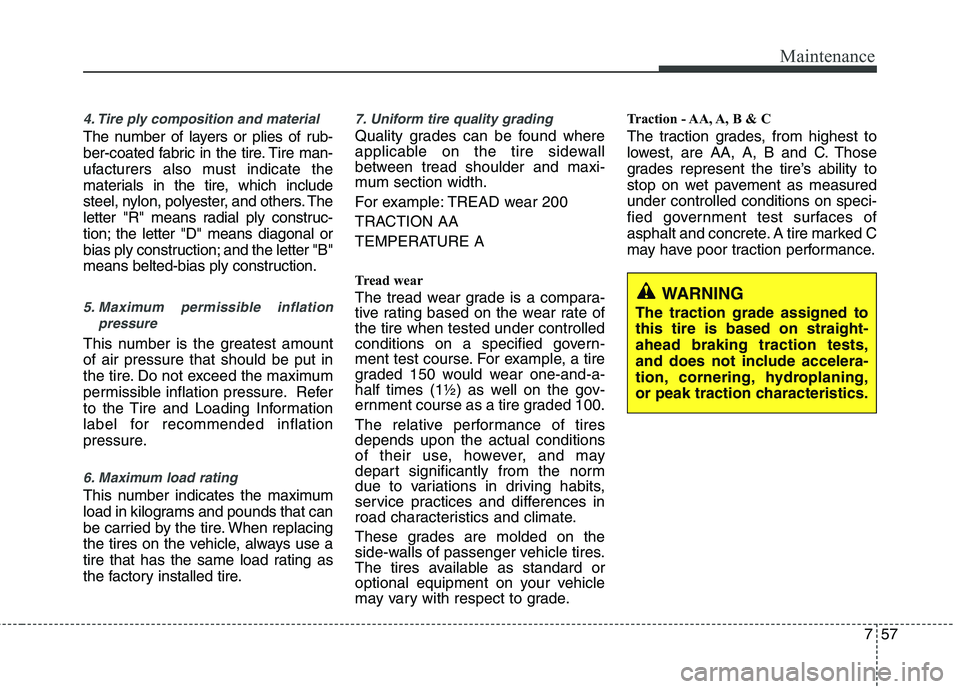
757
Maintenance
4. Tire ply composition and material
The number of layers or plies of rub-
ber-coated fabric in the tire. Tire man-
ufacturers also must indicate the
materials in the tire, which include
steel, nylon, polyester, and others. The
letter "R" means radial ply construc-
tion; the letter "D" means diagonal or
bias ply construction; and the letter "B"
means belted-bias ply construction.
5. Maximum permissible inflation
pressure
This number is the greatest amount
of air pressure that should be put in
the tire. Do not exceed the maximum
permissible inflation pressure. Refer
to the Tire and Loading Information
label for recommended inflation
pressure.
6. Maximum load rating
This number indicates the maximum
load in kilograms and pounds that can
be carried by the tire. When replacing
the tires on the vehicle, always use a
tire that has the same load rating as
the factory installed tire.
7. Uniform tire quality grading
Quality grades can be found where
applicable on the tire sidewall
between tread shoulder and maxi-
mum section width.
For example: TREAD wear 200
TRACTION AA
TEMPERATURE A
Tread wear
The tread wear grade is a compara-
tive rating based on the wear rate of
the tire when tested under controlled
conditions on a specified govern-
ment test course. For example, a tire
graded 150 would wear one-and-a-
half times (1½) as well on the gov-
ernment course as a tire graded 100.
The relative performance of tires
depends upon the actual conditions
of their use, however, and may
depart significantly from the norm
due to variations in driving habits,
service practices and differences in
road characteristics and climate.
These grades are molded on the
side-walls of passenger vehicle tires.
The tires available as standard or
optional equipment on your vehicle
may vary with respect to grade.
Traction - AA, A, B & C
The traction grades, from highest to
lowest, are AA, A, B and C. Those
grades represent the tire’s ability to
stop on wet pavement as measured
under controlled conditions on speci-
fied government test surfaces of
asphalt and concrete. A tire marked C
may have poor traction performance.
WARNING
The traction grade assigned to
this tire is based on straight-
ahead braking traction tests,
and does not include accelera-
tion, cornering, hydroplaning,
or peak traction characteristics.
Page 323 of 372
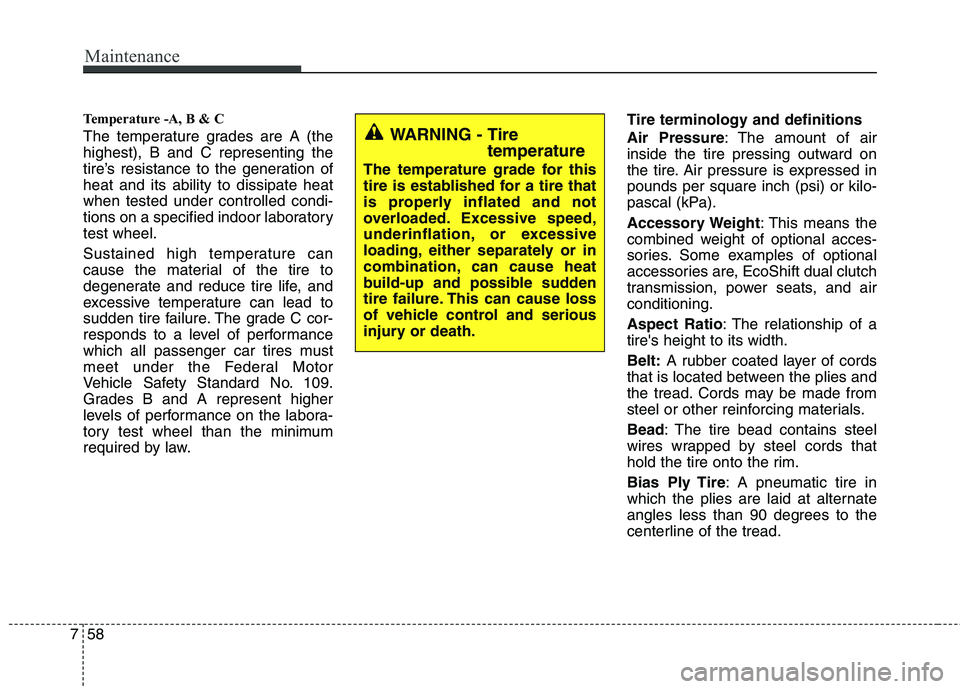
Maintenance
58 7
Temperature -A, B & C
The temperature grades are A (the
highest), B and C representing the
tire’s resistance to the generation of
heat and its ability to dissipate heat
when tested under controlled condi-
tions on a specified indoor laboratory
test wheel.
Sustained high temperature can
cause the material of the tire to
degenerate and reduce tire life, and
excessive temperature can lead to
sudden tire failure. The grade C cor-
responds to a level of performance
which all passenger car tires must
meet under the Federal Motor
Vehicle Safety Standard No. 109.
Grades B and A represent higher
levels of performance on the labora-
tory test wheel than the minimum
required by law.Tire terminology and definitions
Air Pressure: The amount of air
inside the tire pressing outward on
the tire. Air pressure is expressed in
pounds per square inch (psi) or kilo-
pascal (kPa).
Accessory Weight: This means the
combined weight of optional acces-
sories. Some examples of optional
accessories are, EcoShift dual clutch
transmission, power seats, and air
conditioning.
Aspect Ratio: The relationship of a
tire's height to its width.
Belt:A rubber coated layer of cords
that is located between the plies and
the tread. Cords may be made from
steel or other reinforcing materials.
Bead: The tire bead contains steel
wires wrapped by steel cords that
hold the tire onto the rim.
Bias Ply Tire: A pneumatic tire in
which the plies are laid at alternate
angles less than 90 degrees to the
centerline of the tread.WARNING - Tire
temperature
The temperature grade for this
tire is established for a tire that
is properly inflated and not
overloaded. Excessive speed,
underinflation, or excessive
loading, either separately or in
combination, can cause heat
build-up and possible sudden
tire failure. This can cause loss
of vehicle control and serious
injury or death.
Page 337 of 372

Maintenance
72 7
LIGHT BULBS
Use only the bulbs of the specified
wattage.
✽ ✽
NOTICE
After heavy, driving rain or washing,
headlight and taillight lenses could
appear frosty. This condition is caused by
the temperature difference between the
lamp inside and outside. This is similar
to the condensation on your windows
inside your vehicle during the rain and
doesn’t indicate a problem with your
vehicle. If the water leaks into the lamp
bulb circuitry, have the vehicle checked
by an authorized HYUNDAI dealer.
Headlight, position light, turn sig-
nal light, front fog light bulb
replacement
WARNING - Working on
the lights
Prior to working on the light, firmly
apply the parking brake, ensure
that the ignition switch is turned to
the LOCK position and turn off the
lights to avoid sudden movement
of the vehicle and burning your fin-
gers or receiving an electric shock.
CAUTION
Be sure to replace the burned-out
bulb with one of the same wattage
rating. Otherwise, it may cause
damage to the fuse or electric
wiring system.
CAUTION
If you don’t have necessary tools,
the correct bulbs and the expertise,
consult an authorized HYUNDAI
dealer. In many cases, it is difficult
to replace vehicle light bulbs
because other parts of the vehicle
must be removed before you can
get to the bulb. This is especially
true if you have to remove the head-
light assembly to
get to the bulb(s).
Removing/installingthe headlight
assembly can result in damage to
the vehicle.
OFS070025
OFS072025L ■Type A
■Type B
Page 344 of 372
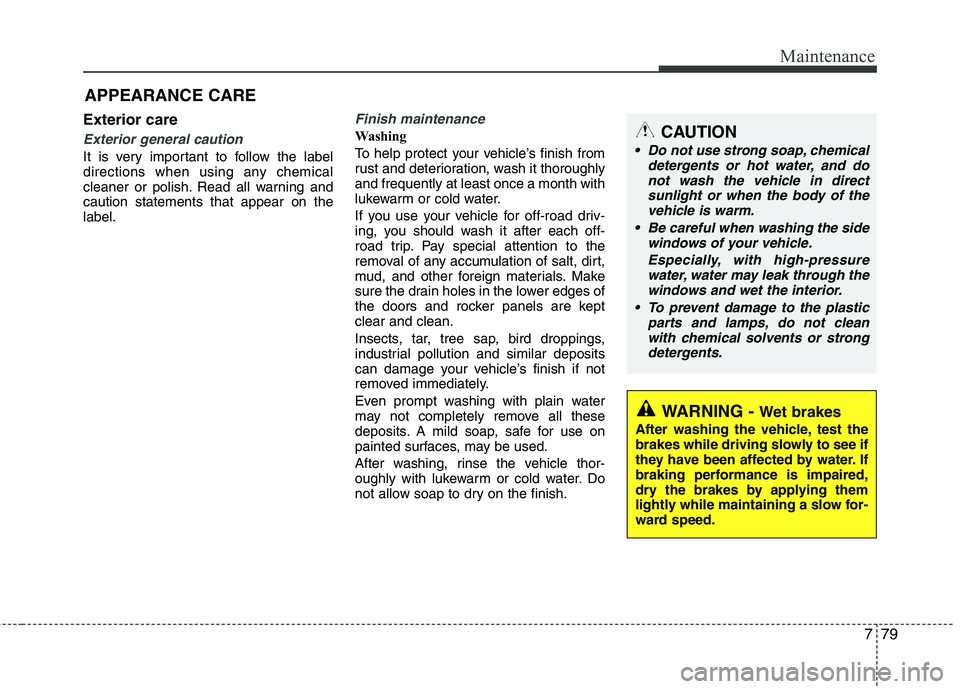
779
Maintenance
APPEARANCE CARE
Exterior care
Exterior general caution
It is very important to follow the label
directions when using any chemical
cleaner or polish. Read all warning and
caution statements that appear on the
label.
Finish maintenance
Washing
To help protect your vehicle’s finish from
rust and deterioration, wash it thoroughly
and frequently at least once a month with
lukewarm or cold water.
If you use your vehicle for off-road driv-
ing, you should wash it after each off-
road trip. Pay special attention to the
removal of any accumulation of salt, dirt,
mud, and other foreign materials. Make
sure the drain holes in the lower edges of
the doors and rocker panels are kept
clear and clean.
Insects, tar, tree sap, bird droppings,
industrial pollution and similar deposits
can damage your vehicle’s finish if not
removed immediately.
Even prompt washing with plain water
may not completely remove all these
deposits. A mild soap, safe for use on
painted surfaces, may be used.
After washing, rinse the vehicle thor-
oughly with lukewarm or cold water. Do
not allow soap to dry on the finish.CAUTION
Do not use strong soap, chemical
detergents or hot water, and do
not wash the vehicle in direct
sunlight or when the body of the
vehicle is warm.
Be careful when washing the side
windows of your vehicle.
Especially, with high-pressure
water, water may leak through the
windows and wet the interior.
To prevent damage to the plastic
parts and lamps, do not clean
with chemical solvents or strong
detergents.
WARNING - Wet brakes
After washing the vehicle, test the
brakes while driving slowly to see if
they have been affected by water. If
braking performance is impaired,
dry the brakes by applying them
lightly while maintaining a slow for-
ward speed.
Page 360 of 372
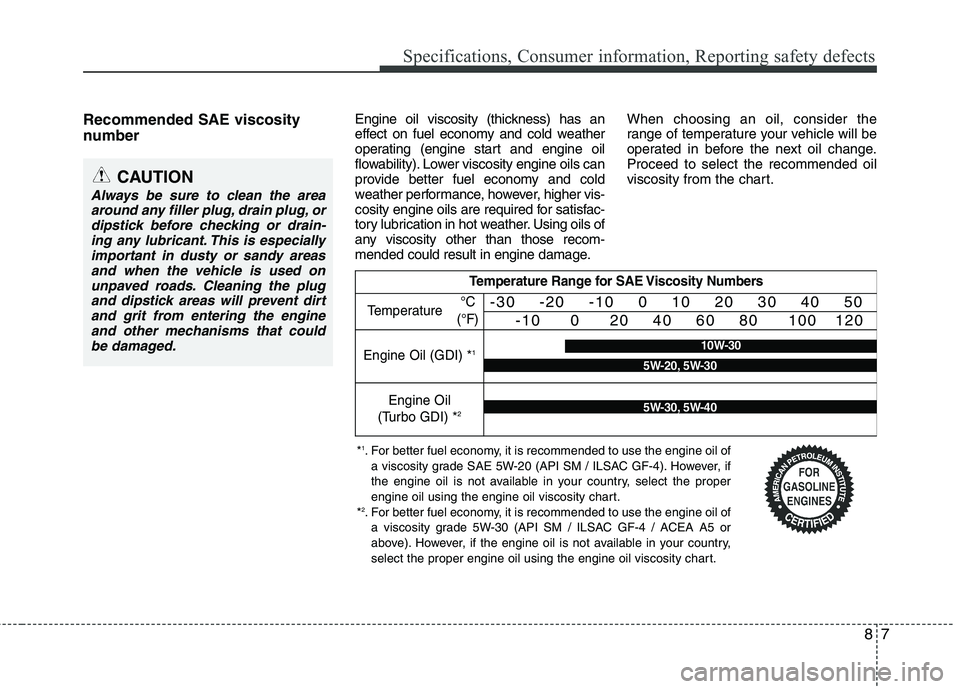
87
Specifications, Consumer information, Reporting safety defects
Recommended SAE viscosity
numberEngine oil viscosity (thickness) has an
effect on fuel economy and cold weather
operating (engine start and engine oil
flowability). Lower viscosity engine oils can
provide better fuel economy and cold
weather performance, however, higher vis-
cosity engine oils are required for satisfac-
tory lubrication in hot weather. Using oils of
any viscosity other than those recom-
mended could result in engine damage.When choosing an oil, consider the
range of temperature your vehicle will be
operated in before the next oil change.
Proceed to select the recommended oil
viscosity from the chart.
CAUTION
Always be sure to clean the area
around any filler plug, drain plug, or
dipstick before checking or drain-
ing any lubricant. This is especially
important in dusty or sandy areas
and when the vehicle is used on
unpaved roads. Cleaning the plug
and dipstick areas will prevent dirt
and grit from entering the engine
and other mechanisms that could
be damaged.
*1. For better fuel economy, it is recommended to use the engine oil of
a viscosity grade SAE 5W-20 (API SM / ILSAC GF-4). However, if
the engine oil is not available in your country, select the proper
engine oil using the engine oil viscosity chart.
*
2. For better fuel economy, it is recommended to use the engine oil of
a viscosity grade 5W-30 (API SM / ILSAC GF-4 / ACEA A5 or
above). However, if the engine oil is not available in your country,
select the proper engine oil using the engine oil viscosity chart.
Temperature Range for SAE Viscosity Numbers
Temperature -30 -20 -10 0 10 20 30 40 50
-10 0 20 40 60 80 100 120
Engine Oil (GDI) *1
Engine Oil
(Turbo GDI) *2
10W-30
5W-20, 5W-30
5W-30, 5W-40
°C
(°F)
Page 364 of 372
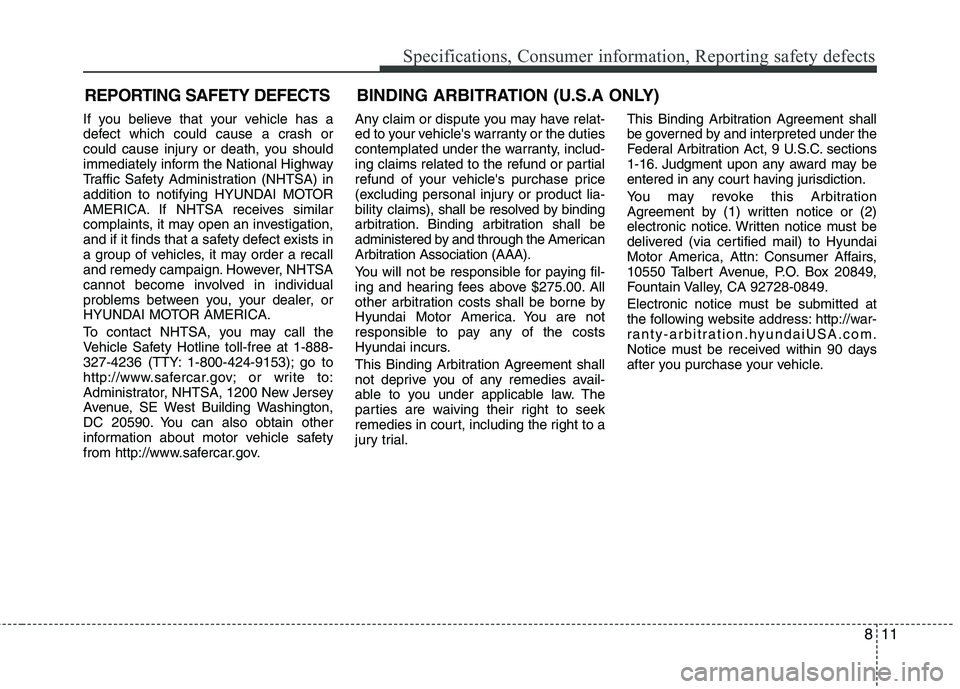
811
Specifications, Consumer information, Reporting safety defects
If you believe that your vehicle has a
defect which could cause a crash or
could cause injury or death, you should
immediately inform the National Highway
Traffic Safety Administration (NHTSA) in
addition to notifying HYUNDAI MOTOR
AMERICA. If NHTSA receives similar
complaints, it may open an investigation,
and if it finds that a safety defect exists in
a group of vehicles, it may order a recall
and remedy campaign. However, NHTSA
cannot become involved in individual
problems between you, your dealer, or
HYUNDAI MOTOR AMERICA.
To contact NHTSA, you may call the
Vehicle Safety Hotline toll-free at 1-888-
327-4236 (TTY: 1-800-424-9153); go to
http://www.safercar.gov; or write to:
Administrator, NHTSA, 1200 New Jersey
Avenue, SE West Building Washington,
DC 20590. You can also obtain other
information about motor vehicle safety
from http://www.safercar.gov.Any claim or dispute you may have relat-
ed to your vehicle's warranty or the duties
contemplated under the warranty, includ-
ing claims related to the refund or partial
refund of your vehicle's purchase price
(excluding personal injury or product lia-
bility claims), shall be resolved by binding
arbitration. Binding arbitration shall be
administered by and through the American
Arbitration Association (AAA).
You will not be responsible for paying fil-
ing and hearing fees above $275.00. All
other arbitration costs shall be borne by
Hyundai Motor America. You are not
responsible to pay any of the costs
Hyundai incurs.
This Binding Arbitration Agreement shall
not deprive you of any remedies avail-
able to you under applicable law. The
parties are waiving their right to seek
remedies in court, including the right to a
jury trial.This Binding Arbitration Agreement shall
be governed by and interpreted under the
Federal Arbitration Act, 9 U.S.C. sections
1-16. Judgment upon any award may be
entered in any court having jurisdiction.
You may revoke this Arbitration
Agreement by (1) written notice or (2)
electronic notice. Written notice must be
delivered (via certified mail) to Hyundai
Motor America, Attn: Consumer Affairs,
10550 Talbert Avenue, P.O. Box 20849,
Fountain Valley, CA 92728-0849.
Electronic notice must be submitted at
the following website address: http://war-
ranty-arbitration.hyundaiUSA.com.
Notice must be received within 90 days
after you purchase your vehicle.
REPORTING SAFETY DEFECTSBINDING ARBITRATION (U.S.A ONLY)
Page 366 of 372
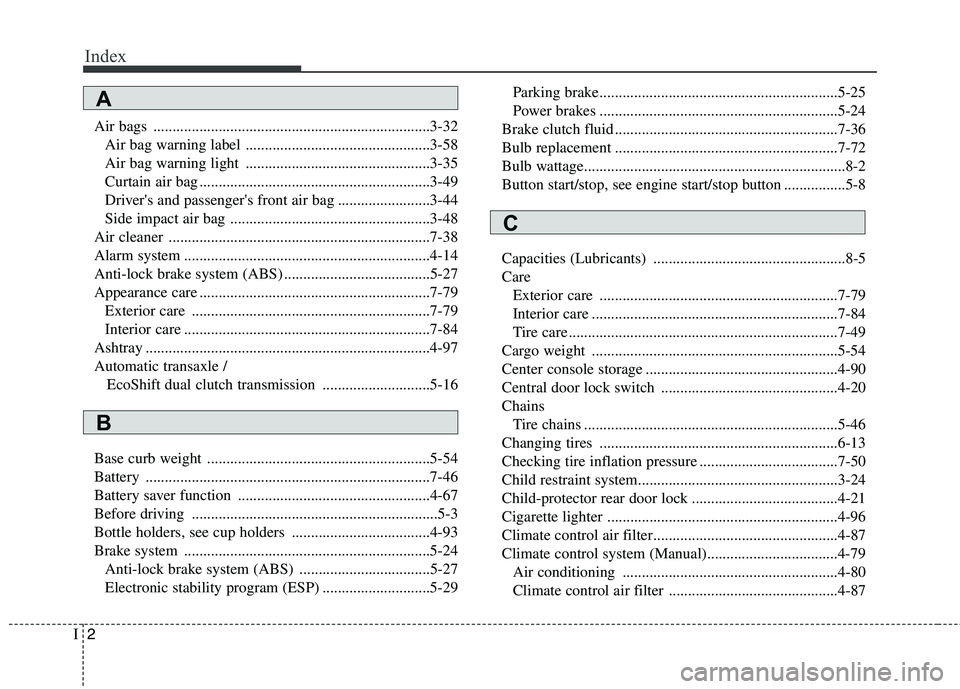
Index
2I
Air bags ........................................................................3-32
Air bag warning label ................................................3-58
Air bag warning light ................................................3-35
Curtain air bag ............................................................3-49
Driver's and passenger's front air bag ........................3-44
Side impact air bag ....................................................3-48
Air cleaner ....................................................................7-38
Alarm system ................................................................4-14
Anti-lock brake system (ABS) ......................................5-27
Appearance care ............................................................7-79
Exterior care ..............................................................7-79
Interior care ................................................................7-84
Ashtray ..........................................................................4-97
Automatic transaxle /
EcoShift dual clutch transmission ............................5-16
Base curb weight ..........................................................5-54
Battery ..........................................................................7-46
Battery saver function ..................................................4-67
Before driving ................................................................5-3
Bottle holders, see cup holders ....................................4-93
Brake system ................................................................5-24
Anti-lock brake system (ABS) ..................................5-27
Electronic stability program (ESP) ............................5-29Parking brake..............................................................5-25
Power brakes ..............................................................5-24
Brake clutch fluid ..........................................................7-36
Bulb replacement ..........................................................7-72
Bulb wattage....................................................................8-2
Button start/stop, see engine start/stop button ................5-8
Capacities (Lubricants) ..................................................8-5
Care
Exterior care ..............................................................7-79
Interior care ................................................................7-84
Tire care ......................................................................7-49
Cargo weight ................................................................5-54
Center console storage ..................................................4-90
Central door lock switch ..............................................4-20
Chains
Tire chains ..................................................................5-46
Changing tires ..............................................................6-13
Checking tire inflation pressure ....................................7-50
Child restraint system....................................................3-24
Child-protector rear door lock ......................................4-21
Cigarette lighter ............................................................4-96
Climate control air filter................................................4-87
Climate control system (Manual)..................................4-79
Air conditioning ........................................................4-80
Climate control air filter ............................................4-87
A
B
C